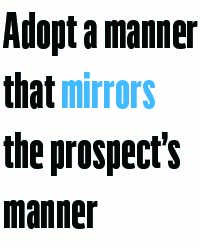Strategy August 22, 2016
7 Tips to Make Your First Time Meetings Count
These seven tips will help you close more sales by taking a consultative approach.

1. Research the Prospect:
Before the meeting, read through the prospect’s company website and social media pages. Learn what you can about the particular buyer you’ll be meeting with from their LinkedIn page and other social media sites. Do online searches about the company and individual. Twenty minutes of research can reveal valuable information you can use to develop good rapport and client-specific questions that help you understand their needs.
2. Read the Prospect’s Communication Style:
Some buyers want to make small talk. Others want to get down to business quickly. It’s incumbent on you to get a sense of what kind of communicator you’re dealing with, and then to roll with it. If someone wants to chat about their weekend or last night’s game, indulge them. On the contrary, if they direct the conversation straight to business, then follow them there.
3. Try Mirroring:
Similarly, adopt a manner that mirrors the prospect’s manner. If the buyer is buttoned-up and corporate, have a formal, polished approach in your tone, language and bearing. But if the prospect is relaxed and informal, then take on a more easygoing air. When you mirror well, you’re more likeable to the prospect, which increases the chances they’ll do business with you.
 4. Don’t Lead With the ‘About Us’:
4. Don’t Lead With the ‘About Us’:
Salespeople often want to share a lot about their company from the outset. Unfortunately, that’s a good way to bore a buyer. Instead of a company bio, start the business conversation by making the meeting about the client. Say something like, “I really want to learn how we can help you. It would be great if we could talk about what your goals are. That way, we can come up with a solution that will work best for you. Would it be OK if I ask you a few questions? Or is there anything you would like to ask me first?” If they ask about you or your company, succinctly relate relevant information. If, however, they give you the green light to proceed with your questions, do so.
5. Ask the Right Kind of Questions:
“Don’t ask closed questions that can be answered with a ‘yes’ or ‘no.’ Instead, ask open-ended questions that elicit a response,” says Diane Ciotta, business author, sales coach and keynote speaker. The questions should focus on determining the client’s specific goals and challenges; should enable you to learn what’s been successful for them in the past and what hasn’t; should make clear to you who their audience is; and their expectations regarding service, delivery and budget.
6. Listen Closely & Ensure Understanding:
Good questions are only useful if you comprehend what prospects are telling you. Pay close attention to what they’re saying and to non-verbal cues, which can potentially yield useful insights. Repeat back to buyers your understanding of key points, and ask them for confirmation on whether or not you’re correct.
7. Ask for the Sale or Establish the Follow-Up:
Once you have a clear understanding of the prospect’s situation, discuss potential solutions with them. If you work out the details of a solution buyers are keen on, ask them if there are any other questions you can answer – anything else they’d like to discuss. If they say ‘no,’ then tactfully ask for the sale. If it’s not feasible to close the sale at the first meeting, then communicate a specific follow-up step, including a timeframe for accomplishing it.
